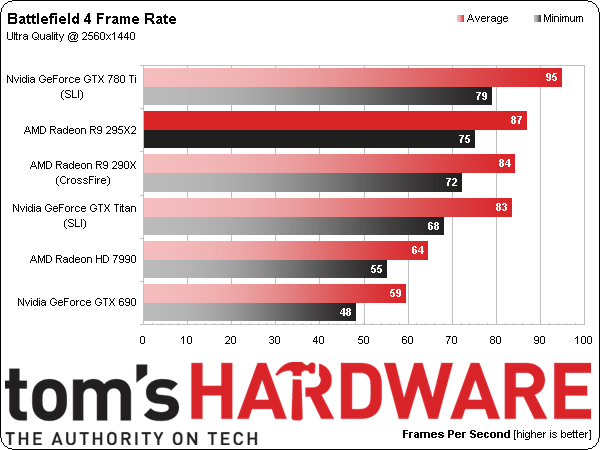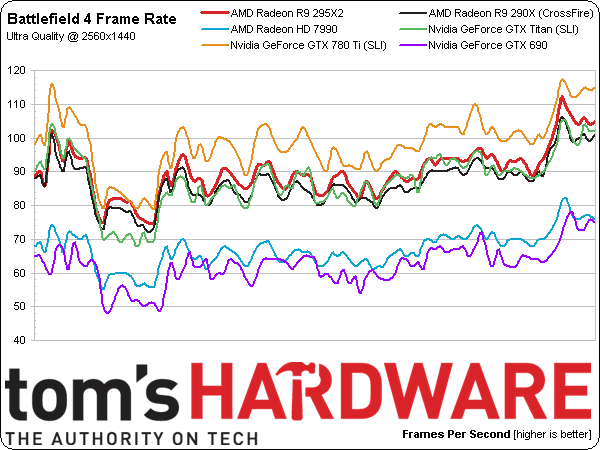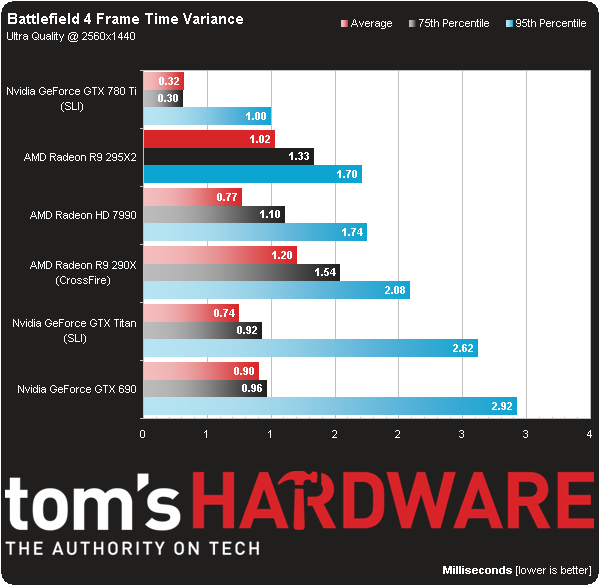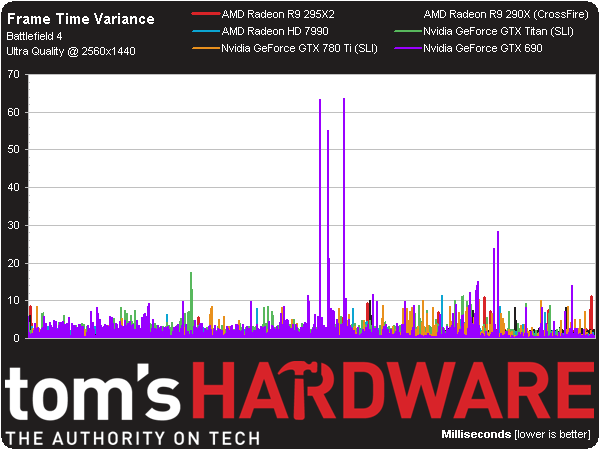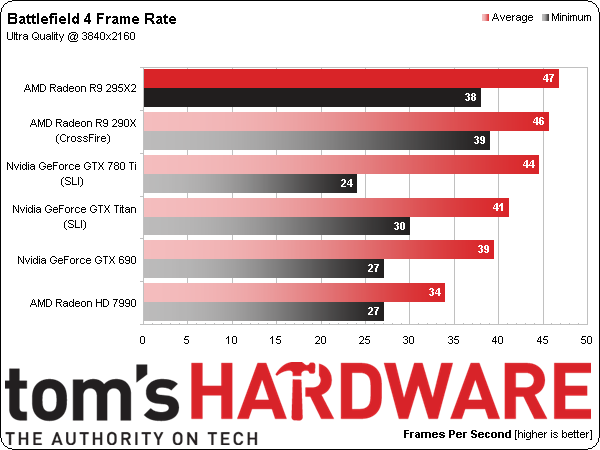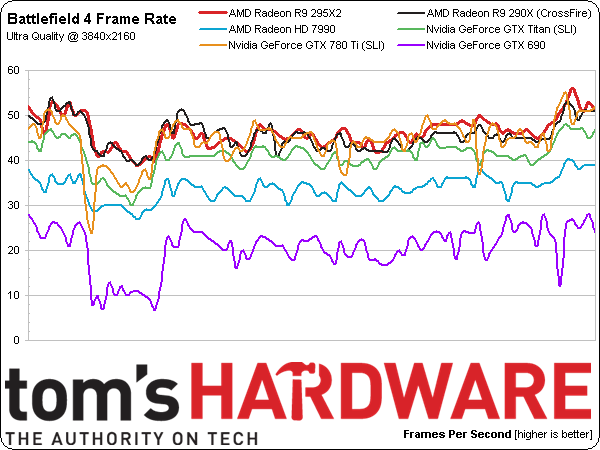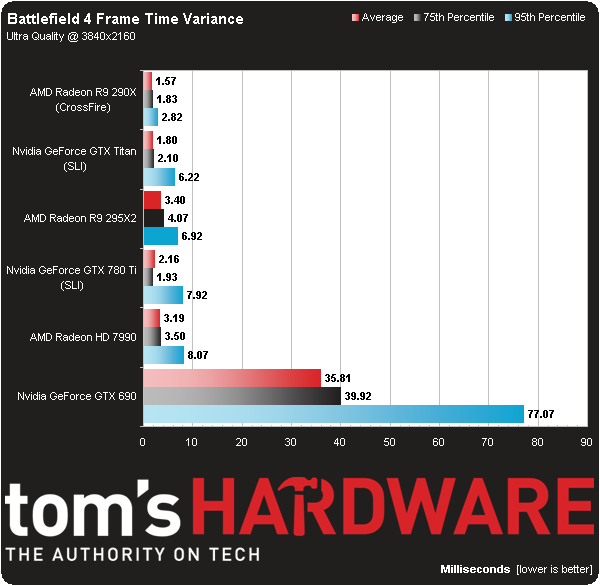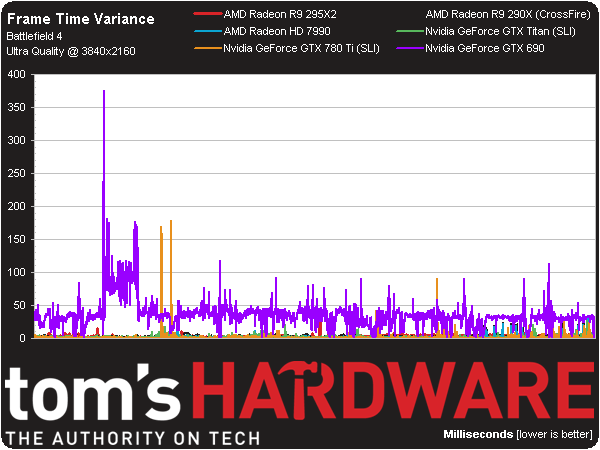Radeon R9 295X2 8 GB Review: Project Hydra Gets Liquid Cooling
“Do you have what it takes?” AMD asks, purportedly referring to the big budget and beefy power supply you need before buying its new Radeon R9 295X2. We benchmark the 500 W, dual-GPU beast against several other high-end configs before declaring a winner.
Results: Battlefield 4
2560x1440
Thanks to a slightly higher clock rate, the Radeon R9 295X2 inches past a couple of R9 290X cards in CrossFire. However, a recent driver update from Nvidia gives two GeForce GTX 780 Tis the upper-hand in Battlefield 4…at least at this resolution. Two GTX Titans hang in there as well, even if lower core frequencies and fewer shaders force the $1000 boards in behind a pair of AMD’s single-GPU flagships.
In comparison, the once-mighty Radeon HD 7990 and GeForce GTX 690 are humbled. At least they’re still plenty-fast at Battlefield 4’s most taxing detail preset.
The highs and lows are best-seen by charting out frame rate over time.
Both AMD and Nvidia do a great job of pacing frames out consistently. Our 95th percentile numbers—a near-worst-case—remain under 3 ms, and only Nvidia’s GeForce GTX 690 approaches that figure.
Aside from a few major spikes from Nvidia’s GeForce GTX 690, measured frame times in Battlefield 4 are low.
3840x2160
Battlefield 4 uses quite a bit of graphics memory. So, it’s not surprising to see the dual-Hawaii-based configurations doing really well, while two GeForce GTX 780 Ti cards (each with 3 GB on-board) experience lower minimum frame rates at 3840x2160. Titans have 6 GB each and manage more playable minimums. But because they come equipped with fewer shaders and lower clock rates, average performance drops to fourth place.
Once, and only briefly, the Radeon R9 290Xes and 295X2 fall under 40 FPS. Otherwise, they’re perfectly playable.
Get Tom's Hardware's best news and in-depth reviews, straight to your inbox.
The GeForce GTX 780 Tis are almost as fast on paper. However, you can see more punctuated dips in the frame rate over time chart. In fact, as you play through the Tashgar level used for this test, you’ll see the characters pop in and out of view. A log of memory use through the run shows 3 GB being exceeded easily, which is why I’d hold off on recommending GeForce GTX 780 Tis for 4K.
Overall, frame time variance is reasonable, though the 690 throws off our bar and line charts. Spikes from the 780 Tis correspond to dips seen in the frame rate over time graph.
Current page: Results: Battlefield 4
Prev Page Results: Assassin’s Creed IV: Black Flag Next Page Results: Grid 2-
Marsian Gustrianda Many people doubt about Dual GPU Hawaii will be Blow Up. It seems AMD really do well job. Nice Looking CardReply -
ohim This card is like the Veyron of WV , show the world what you can do (R295x2) but you`ll still relay on the sales of your WV Golf for revenue (270x, 280x)Reply -
outlw6669 Impressive performance, temperatures and fairly low noise!Reply
I would prefer a bit lower price, but this looks like a great card for the gamer that has everything! -
gunfighter zeck the name Dreadnaught originated from Dread Nothing or, fear nothing.Reply
Boss ship. -
Maxamus456 Hope this price stays low and not get bloated from bit con miners like its predecessors.Reply -
blubbey So let me get this straight. It runs pretty cool, quiet, performs well and (for the moment) is able to play a good selection of games at 4k admirably and is priced competitively. Plus if you are going to drop a bit more on watercooling your GPUs (which is a possibility if you're spending $1200+) that gives this card even greater value. Nice work AMD.Reply -
marciocattini Wheres Tom's Hardware seal of approval? =( clearly this card diserves some love!Reply
